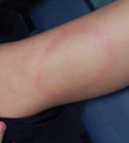Healthy Living
Lyme Disease: Prevention and Symptoms
Lyme disease has made its way to Western New York. In the summer months, it’s important to be extra vigilant about prevention in order to avoid infection. UR Medicine infectious disease expert Dr. Jennifer Nayak offers a few tips that can help you avoid a tick bite, and a few things to look for if you fear you may have been exposed.
Tips for prevention:
- Wear long pants that protect your legs. Since this isn’t always possible due to the heat, try to avoid areas with tall grasses, and walk in the center of nature trails where there is less brush and undergrowth.
- Use insect repellent. The EPA has a helpful website that can help you find what kind of insect repellents are right for you and your family.
- Conduct a full-body check using a mirror to inspect all parts of your body after returning from areas that may have ticks. Important places to check include under arms, in and around ears, and in hair.
- Remember to also check your children, pets and loose clothing.
I was bitten by a tick. Now what?
- If you have not done so already, remove the tick using tweezers. Use steady, even pressure to pull the tick away. Do not use heat or other folklore remedies. Thoroughly clean the bite area.

- Lyme disease is only transmitted by Ixodes ticks. If the tick has been attached to you for less than 24 hours, it is unlikely you will have contracted the disease.
- An initial small bump or redness at the site of the tick bite lasting 1 to 2 days is typical and does not mean that the person has acquired Lyme disease.
- Common early symptoms of Lyme disease include an expanding “bull’s-eye” rash at the site of the tick bite, fever, aches, and swollen glands. These symptoms can occur between 3 and 30 days after the initial bite. If you develop symptoms possibly consistent with Lyme disease, you should contact your doctor for evaluation.

- Symptoms that can develop after 30 days in untreated people include headaches and neck stiffness, facial droop, or arthritis with joint pain and swelling (especially in large joints such as the knees).
- If you experience any of these symptoms in the aftermath of a tick bite, contact a doctor right away. With timely detection and diagnosis, patients with Lyme disease recover after treatment with antibiotics.
Photos courtesy of the Centers for Disease Control
Jennifer Nayak, M.D., is a pediatric infectious disease specialist at UR Medicine’s Golisano Children’s Hospital.


